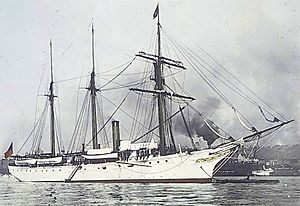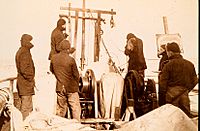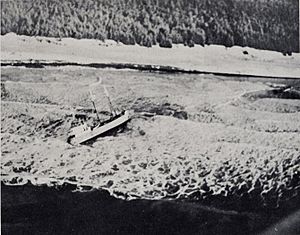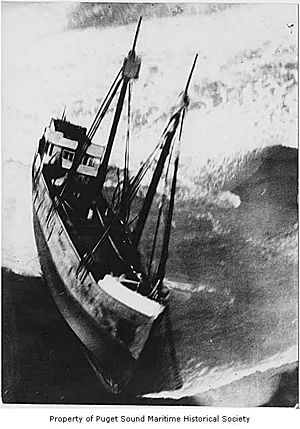- This page was last modified on 17 October 2025, at 10:18. Suggest an edit.
USC&GS Carlile P. Patterson facts for kids
The USC&GS Carlile P. Patterson was a special ship that worked for the United States Coast and Geodetic Survey. Its main job was to explore and map the oceans, especially around Alaska. This ship was active from 1883 to 1918. After its time as a survey ship, it briefly served in the Navy and then worked as a merchant ship for 15 years. Sadly, it was wrecked off the coast of Alaska in 1938.

USC&GS Carlile P. Patterson
|
|
| History | |
|---|---|
| Name | USC&GS Carlile P. Patterson |
| Namesake | Carlile P. Patterson (1816–1881), Superintendent of the United States Coast and Geodetic Survey |
| Owner |
|
| Ordered | 1883 |
| Builder | James D. Leary, Brooklyn, New York |
| Cost | $100,000 |
| Launched | January 15, 1884 |
| Sponsored by | Miss Katie Patterson, daughter of the late Capt. Carlile P. Patterson |
| Commissioned | April 1, 1884 |
| Recommissioned | 1918 (United States Navy) |
| Decommissioned | 1919 |
| In service | 1884–1919, 1924–1938 |
| Out of service | 1919–1924 (?) |
| Renamed | Forward, August 15, 1918; Patterson 1924 or earlier |
| Fate | Wrecked, 1938 |
| General characteristics | |
| Type | Survey ship |
| Tonnage | 604 |
| Displacement | 719 |
| Length | 163 ft (49.7 m) |
| Beam | 27.4 ft (8.4 m) |
| Draft | 14.2 ft (4.3 m) |
| Depth of hold | 10.3 ft (3.1 m) |
| Decks | 2 |
| Deck clearance | 7 ft (2.1 m) upper deck |
| Installed power | Cross compound vertical steam engine, cylinders 17 and 31 inches × 28 inch stroke, 215 ihp; replaced by 325 hp diesel 1924 |
| Propulsion | 8 ft screw |
| Sail plan | Barkentine |
| Speed | 7–9 knots (13–17 km/h; 8.1–10.4 mph) (steam) |
| Boats & landing craft carried |
7 |
| Crew | 12–13 officers, 40–46 crewmen |
| Armament | Gatling guns; 2 × 6-pounder guns during naval service |
Contents
Building the Patterson
The ship was named after Carlile Pollock Patterson. He was an important leader of the Coast Survey. The New York Times newspaper said that Commander Colby Mitchell Chester designed the ship. It was built from wood in Brooklyn, New York.
The Patterson had a strong hull with iron braces. It also had five watertight walls inside to keep it safe. The ship used a steam engine for power and could carry a lot of coal for fuel. It was also rigged with sails like a barkentine, which is a type of sailing ship.
One cool piece of equipment on board was the Sigsbee piano-wire sounding machine. This was a very advanced tool for mapping deep parts of the ocean. It could hold five miles of wire to measure how deep the water was.
Adventures as a Survey Ship
The Carlile P. Patterson started its journey to the west coast in July 1884. It sailed all the way around South America through the Straits of Magellan. It made many stops along the way, including places like Rio de Janeiro and Panama. The ship finally arrived in San Francisco in February 1885.
Soon after, the Patterson began its important work. It was mostly used to map the coast of Alaska. The ship's crews even named many places in Alaska during their surveys. It also worked in other areas on the west coast and around the Hawaiian Islands.
In 1914, the Patterson helped rescue 26 crew members. Their ship, the USRC Tahoma, had hit a hidden reef in the Aleutians and sank. This was a brave rescue mission!
In 1918, during World War I, the Carlile P. Patterson was given to the United States Navy. It was renamed Forward and helped patrol the waters off Alaska and Mexico. After the war, it was returned to the Coast and Geodetic Survey in 1919. However, the Survey decided the ship was too old and slow for its work. So, it was sold.
Life as a Merchant Ship
In 1924, the Carlile P. Patterson was sold to a new company. They changed it into a "motorship" by replacing its steam engine with a diesel engine. The ship was also rebuilt. Some parts, like its deckhouse and bowsprit, were removed. Its front part was reshaped, and its masts were changed.
The ship was then bought by the Northern Whaling and Trading Company in 1925. For many years, it worked as an Arctic trading ship. It sailed between San Francisco and Herschel Island, stopping at different places along the Alaska coast. Later, it was used for carrying cargo.
The Shipwreck
The Patterson was wrecked on December 11, 1938. It ran aground near Cape Fairweather in the Gulf of Alaska. It was a stormy day with heavy rain. The ship was traveling from Kodiak to Seattle when it got stuck.
During the shipwreck, the first mate was washed overboard and lost. Another crewman drowned trying to set up a rope to help everyone get to shore. The 18 survivors stayed on the ship until the water went out. Then, they reached the beach. They survived by eating supplies dropped from airplanes.
Two men were flown out by a brave pilot named Sheldon Simmons. He landed his plane in a nearby creek. The rest of the men hiked to Lituya Bay with a guide. They were then picked up by Navy planes and a Coast Guard cutter. Most of the ship's cargo was saved the next spring. However, the Patterson itself was broken into pieces by the strong waves.









